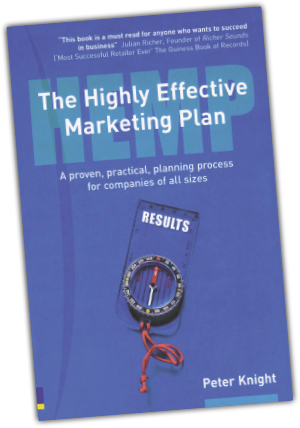
Consequences.

One of the many benefits of being a dealer of HEMP (Highly Effective Marketing Plan) is the variety of businesses I get to work with.
In 2019 I’ve visited a foundry in the black country and helped them to sell more manhole covers and polished plaques for posh ovens, a pub chain (which also secured me 3 cases of the finest Italian red wine I’ve ever drunk), a manufacturer of containers that sells them for just about anything other than transporting products, a fruit farm that has met its sales targets for the next decade already thanks to long term deals with Bulmers and Ribena, a software company that could be on course for a £1billion valuation within 12 months and a poultry farm that’s cut it’s payroll to 1.5 people – to list just a few.
Despite their variety and diversity they all have a common issue – as do you.
They will never get it all done. Every one of these businesses, and I bet yours too, has far more ideas than resources, finance and time available. That’s why the first three steps of HEMP are so important.
Step One – What’s the Desired Result?
Notice it’s singular, desired result (not results). I believe it essential to break things down to the appropriate level of granularity in order to be able to properly evaluate them. The desired result needs to be something that excites you, the team and customers. It must be worthwhile and relevant. It should be timed, “by when” and measurable.
For example, “our desired result is to increase sales by 10%” is really poor. Even worse, “we want to increase brand awareness” – that’s a shocker. What does work is, “we want to sell 23 more detached houses in 2020 than we achieved in 2019 (from 142 to 165) at our scale fee of 1.5%+VAT.” Another excellent desired result could be, “we will recruit 3 additional property managers, all of whom have three years relevant experience and meet our selection criteria, by March 31st 2020.”
Step Two – What’s it worth?
There are three things you need to calculate: income, profit and timetable. Let’s take the house sales example:
- Income: (23 x £350,000) x 1.5% = £120,750
- Profit: (Average gross margin of 65%) = £78,488
- Timetable: 5 additional listings per month, January-September inclusive
This is the first check to make sure your desired result is worth pursuing. Sometimes you might have what feels like a great idea (often at 4am when you wake up all excited), but when you crunch the numbers it actually isn’t worth pursuing, not least as there are other things, too many in fact, that you can invest in.
Step Three – What are the consequences?
Remember Newton’s third law: every action has a reaction. There are consequences for every action you take – and also for every inaction too. Sometimes these are unintended but is that because they couldn’t have been foreseen or just weren’t properly considered?
I like to think about the upsides and downsides of doing something, the upsides and downsides of not doing something. And yes, there are always these four. If you can’t think of an upside of not doing something or a downside of completion then it will be there and you’ll find out after the event, when often it’s too late.
Let’s stick with the house sales case study.
- Upsides of achievement: increased income, profit and market share.
- Downsides of achievement: potential to be seen as upper market only and lose share of smaller properties. Strain on sales progression team due to increased number of chains. Longer cash flow profile.
- Upsides of not doing: maintain our middle market position. Time to focus on opening new branch and call centre.
- Downsides of not doing: allowing competitor(s) to increase market share and appear more able in the higher end market. Waste of listers ability to secure higher fees on higher priced properties. danger lister could be tempted to leave.
I’m sure you will identify many other potential consequences but I hope it paints the picture and makes the point that you need to consider in advance of action what the positive and negative reactions to your desired result might be.
Having completed these three steps you can then determine whether this particular desired result is worthy of your time, effort and funding right now. If not then file it in the “not doing now folder” (I have a very large one) which you can review every so often to see if an idea that wasn’t right before might now be just the ticket.
If you want a HEMP template drop me a line and I’ll be pleased to send you one.
Join over 6,000 property professionals, including leading estate and letting agents and receive information, insight, ideas and inspiration (four-i) from top estate agency coach Peter Knight, straight to your inbox every Monday. Join now
Agree or disagree with the views expressed in this newsletter? Share the article and your views on social media today.
Follow our social channels here: